Cover Photo provided by Mr. Jim Hartsell
Editor's note: When it came time to roll out our (long overdue) new website we wanted to do something celebrating the people we've met through golf and the places that are still out there for us to explore. We've only scratched the surface on who we need to meet and where we need to go. Jim Hartsell embodies that spirit to the fullest. I met Jim through Sweetens Cove a few years ago and we became fast friends. He's spent the last two-and-a-half decades exploring Scotland and digging deeper than nearly any American I know, non-Tom Coyne division. As an Registered Building Architect, he brings a unique perspective to golf travel, both on and off the course. We're thrilled to roll this series out over the next few months and hope you enjoy. - Tron
The Hidden Soul of the Game
The Golf House Club, Elie
By Jim Hartsell
Elie: The Elegant and Ethereal Home of James Braid
It is believed that golf has been played on the links of Elie in the East Neuk of Fife since the 16th century. Most historians attribute the design of the current layout to Old Tom Morris in 1895. James Braid, the legendary 5 time Champion Golfer of The Year, and golf course Architect, was born in the adjacent village of Earlsferry in 1870. He won his first tournament at age 8 on the links at Elie. Some historical accounts mention that Braid himself made revisions to the course in the 1920’s. However, this claim is not substantiated (or even noted) in the essential and definitive “James Braid and his Four Hundred Golf Courses,” by John F. Moreton and Ian Cumming, so I am inclined to believe Braid did not actually work on his childhood course. In spite of this, we only have to look at the understated elegance of just a few of Braid’s fully credited designs - Brora, Panmure, Fraserburgh. Kilspindie, Millport, Stranraer, Boat of Garten, St. Enodoc - to see the massive influence that Elie had on his design philosophy.
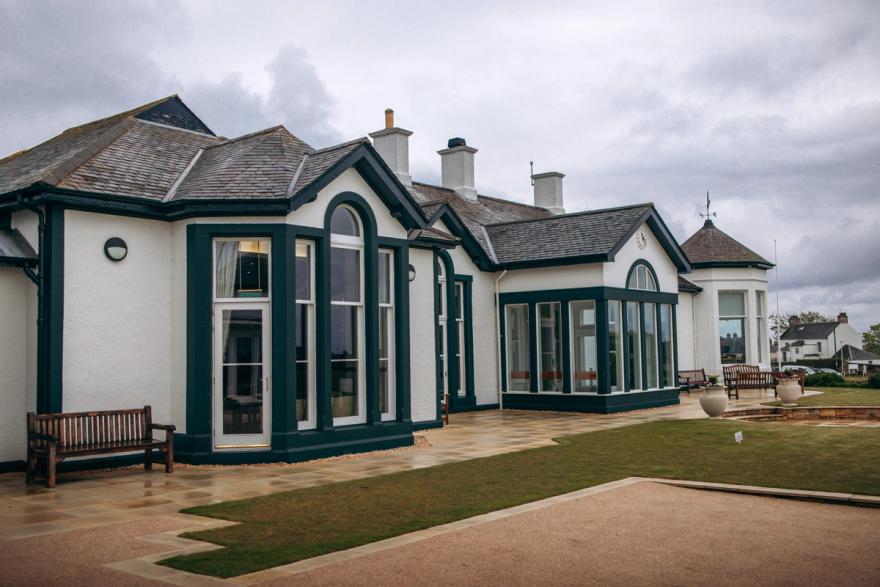
The Club House at Elie. Photograph by Jim Hartsell
The Golf House Club (commonly called Elie) is located a mere 5 miles from Anstruther. Fife has so many truly great golf courses, in such a concentrated area, that it can be difficult for the visiting golfer to decide where to play. The decisions on which clubs to visit can seem monumental to a visiting golfer, because they are - each day of a Scottish golf trip is precious. If you are fortunate enough to visit Fife, you must make time to play at Elie.
Elie measures 6,233 yards and has 16 par fours and 2 par threes, for a strict par of 70. In my experience, this is a very unique assembly of holes. On the surface, such a seemingly bland assortment might seem to be a recipe for monotonous golf. It is not. The Golf House Club is a sheer delight, from start to finish. The pair of par threes are two of my favorites in Scotland.
We arrived early for our 12:30 tee time and were greeted warmly by the Head Professional Gavin Cook. Mr. Cook’s well-stocked shop has to be among the most singular in golf. A Royal Navy submarine periscope, salvaged from the HMS Excalibur in 1966, is mounted in the center - and extends through the roof of the small octagonal shop, which is curiously detached from the beautiful clubhouse. The periscope allows the staff to see if the fairway is clear beyond the hill, over which the blind opening tee shot is played. I can’t think of anything else remotely like this in the world of golf.

The Periscope at Elie. Photograph by Jim Hartsell
The course was not crowded on a Tuesday afternoon and we were told we could go off immediately, “But I’m sure you’ll be wanting some lunch first,” the friendly pro said. We did indeed. When playing golf in Scotland, I always recommend that you have lunch in the clubhouse, whether before or after your round. (Note to Americans: Remove your hat when entering the clubhouse!) The Scots have mastered the art of the perfect lunch: a “toastie” (a small toasted sandwich) and soup. A pint of Tennent’s before assaying the 1st at Elie is never a bad idea either.
We each had the ham and cheese toastie with potato-leek soup. It was - as with most things in Scottish clubhouses – simple, yet perfectly executed and beautifully presented. I mention all this to relay an incident that occurred as I was paying our bill at the kitchen window. It was a nominal amount, around 20 pounds for the 3 of us. The service had been excellent. As I paid with a 20 pound note, I also offered the steward a 5 pound tip. He quickly said, “Oh no, sir, that is too much. I cannot accept that.” A little confused, I asked, “How much should I give you?” “A pound will be sufficient, sir,” he replied with a smile. Can you imagine this same scene occurring in an American clubhouse?

Lunch at Elie. Photograph by Jim Hartsell
With lunch taken care of, and 4 pounds richer for it, we walked back to the Starter’s House / Pro Shop and Gavin told us to play away. It was a somewhat overcast day, but a very pleasant 60 degrees. The blind opening shot at Elie sums up the essence of Scottish golf. You play away over the hill, trusting that the white marker in the distance will lead a well struck drive to the safety of the fairway beyond. One of the great joys of golf is cresting a hill after a blind shot to see where your ball has finished. This singular golf pleasure occurs often at Elie, with blind shots appearing with a wonderful frequency. The 420 yard par four 1st hole perfectly sets the tone for what will surely be one of the most enjoyable links you will ever play. On this early afternoon, the constant 20 mph breeze was directly behind us as we started.
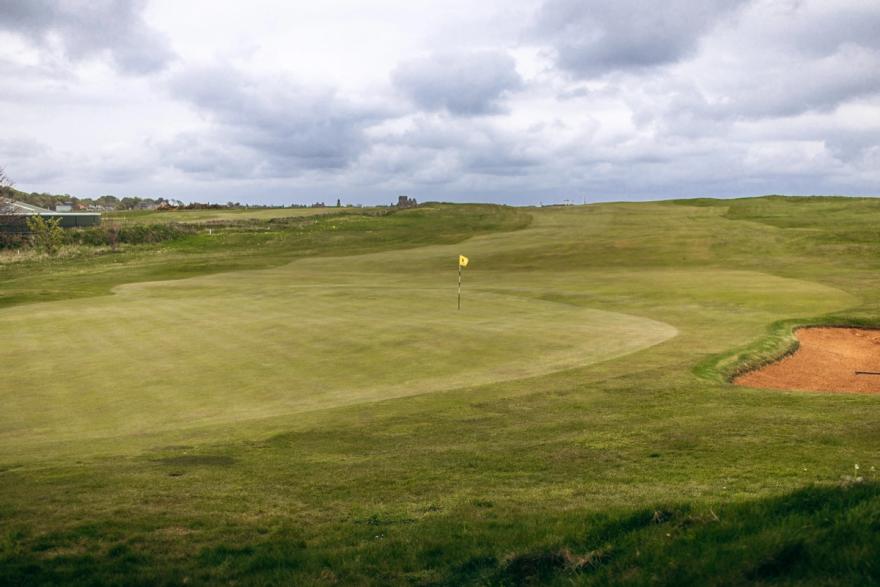
1st Green at Elie. Photograph by Jim Hartsell
There is a feeling of constant movement - of the progression of golfers in the distance as they matriculate around the links - that is prevalent at Elie. The 284 par four 2nd plays back up the hill - and directly back into the wind that assisted us on the 1st - to one of my favorite greens in the world. I have mentioned previously that yardage is irrelevant in Scotland. The 2nd hole, a full 136 yards shorter than the 1st, played at least two clubs longer than its predecessor on this day. Upon reaching the elevated and exposed green, you can be forgiven for pausing to take in the entire wondrous scene of the links and town that unfolds in front of you. The ocean is in view from the rolling dune land for the next 15 holes. This is one of the great vistas in all of Scottish golf.
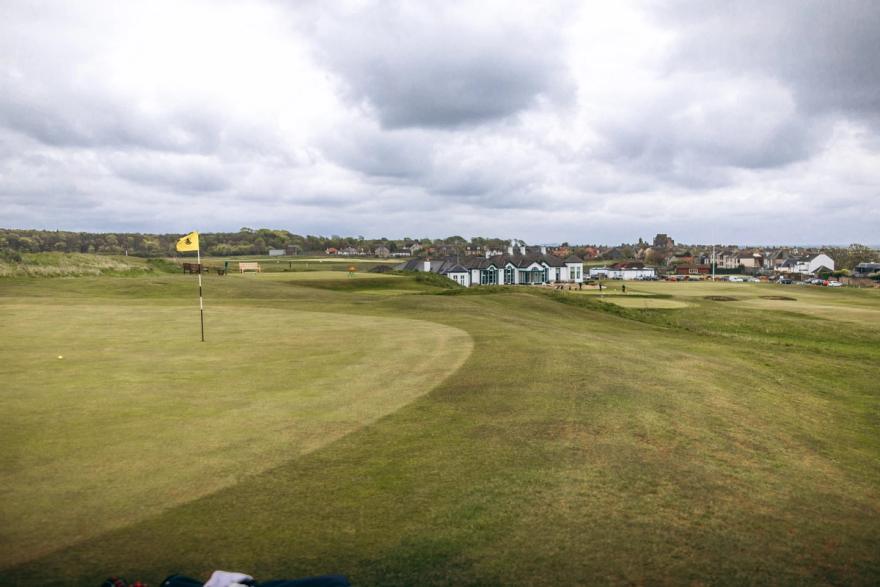
2nd Green at Elie with Club House beyond. Photograph by Jim Hartsell
The par three 3rd hole plays 204 yards downhill to a brilliantly sited green, with deep bunkers guarding the right and left flanks like ancient Scylla and Charybdis. A word about the bunkers at Elie – they are deadly. The village, with all its charming Victorian structures, borders the left side of the hole. This spot - the 2nd green and 3rd tee at Elie - ranks in the upper echelon of places to be in the entire world. We stood on the tee in silence for a few seconds before Jake said quietly, “Wow.” You might even imagine that you can see all the way over the Firth of Forth to North Berwick on a clear day. One of only two single-shot holes on the entire course, a par on the 3rd hole is well earned.
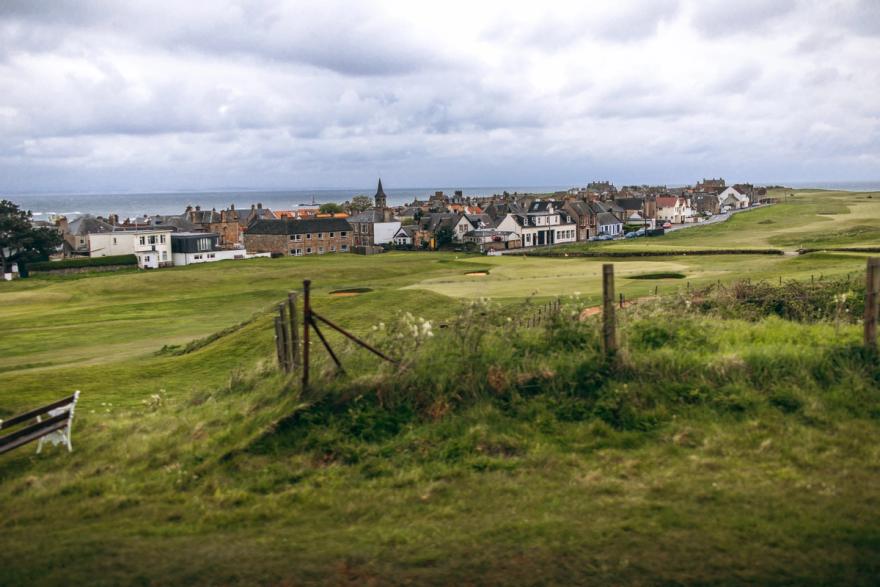
View from the 2nd hole at Elie looking into town. Photograph by Jim Hartsell
Approaching the 4th tee, golfers will notice a small pub just a few steps from the teeing ground. On an increasingly cold and cloudy day, the 19th Hole Pub looked warm and inviting. With no golfers in view behind us, we ducked in for a restorative wee dram of Bowmore whisky. The proprietor greeted us warmly and we discussed how her business had been of late. If the course is not crowded, you must stop in for a dram or pint. If you need to keep moving, you can always come back for a longer visit after your round. It is my sincere hope that the pub has been able to survive the current world pandemic and economic crisis. The world needs places like the 19th Hole Pub in Elie.

Whiskey and a Pint at The 19th Hole Pub. Photograph by Jim Hartsell
There is not a bad hole on this ethereal, mighty and ancient linksland. The 4th and 5th holes continue the outward trek away from the clubhouse and lead us to the 6th, which deserves a special mention. It is a short par 4 at a seemingly insignificant 306 yards. The drive is completely blind. If the last group of hidden bunkers beyond the ridge are carried (possible, with a helping wind), the ball careens wildly towards a large, sloping green. The backdrop of the green is simply the North Sea. There are several bunkers to be avoided - which are basically a stroke penalty anywhere at Elie. This hole once again demonstrates why the experience of Scottish golf cannot be replicated in other parts of the world, as much as a designer might make the attempt.

The 4th Green, with the village of Elie beyond. Photograph by Jim Hartsell
We laughed out loud at the 6th hole – it is pure golfing fun. As we putted out on the wild green, the clouds were growing more ominous in the south and the wind started gusting to 30 mph. As the great Peter Alliss often said during Open coverage, “If you don’t like the weather in Scotland, just wait a few minutes. It will change.” There is sometimes a valid reason for a cliche’s existence.
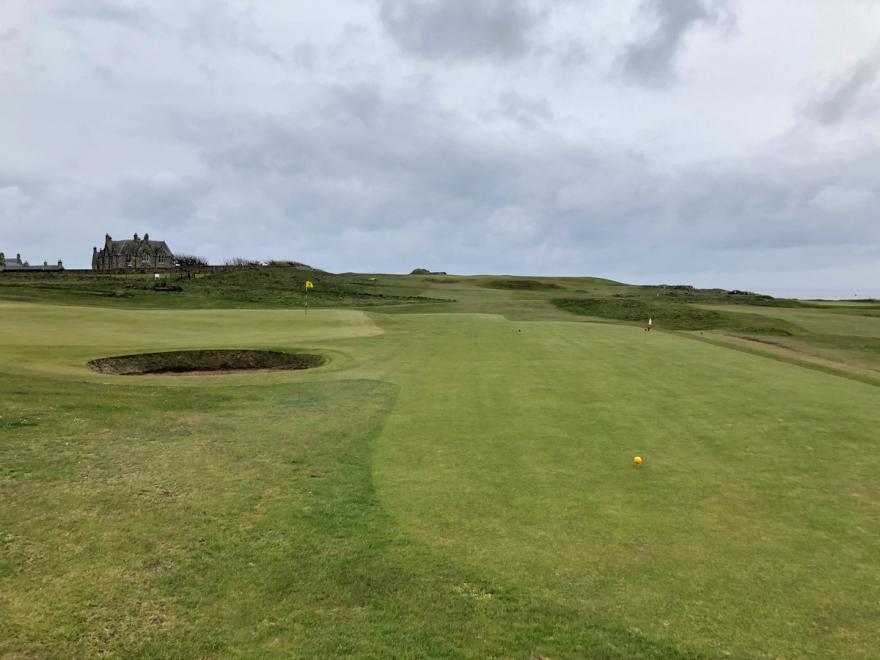
6th Green and 10th tee. Photograph by Jim Hartsell
The routing at Elie is unusual and brilliant. Old Tom, in his wisdom, chose to take the 7th and 8th and 9th holes back inland away from the ocean, in a somewhat circular pattern. This creates totally different playing conditions on these three difficult par fours. The 7th, a short 241 yard, semi-blind par 4 is a particular favorite.
At the end of this circular and interesting inland journey lies another 3 hole stretch, the 10th, 11th and 12th, that rivals any triumvirate of holes on the planet. All 3 holes are hard by the sea, which has grown increasingly unsettled on this day. The 10th is a perfect golf hole. It plays blind from the tee at 280 yard - over a rocky hill with the wind most likely blowing across - to a wonderful semi-punchbowl green. Once again, if the ridge is carried from the tee, the ball careens downhill towards the hold. This is the pure, unfiltered essence of golf. I imagine there are eagles and triple bogeys in equal measure on this hole, depending on the wind. It is a lovely and brilliant golf hole.

The 10th Green at Elie. Photograph by Jim Hartsell
The 131 yard 11th is the second and final par 3 at The Golf House Club. It is great, memorable and if that is not enough - hard by the sandy beach. The wind coming off the ocean was now creating a havoc that cannot adequately be described with the written word. It took a concerted effort to not get blown over by the gusts. After we hit our tee shots on the 11th, all Hell broke loose. A storm of Old Testament proportions came in off the North Sea. We managed to finish the hole, still somewhat in one piece. On the 12th tee, the rain was blowing sideways with such force that it stung painfully as it hit our faces. We saw a few other golfers conceding to the weather and making the long walk in. From the tee, it was obvious that the 12th is a great hole. Jake asked me, “Should we go in, Dad?” I said, “Well, we are probably 3 miles from the clubhouse. We’re out here and who knows when we’ll be back. We might as well finish now.”
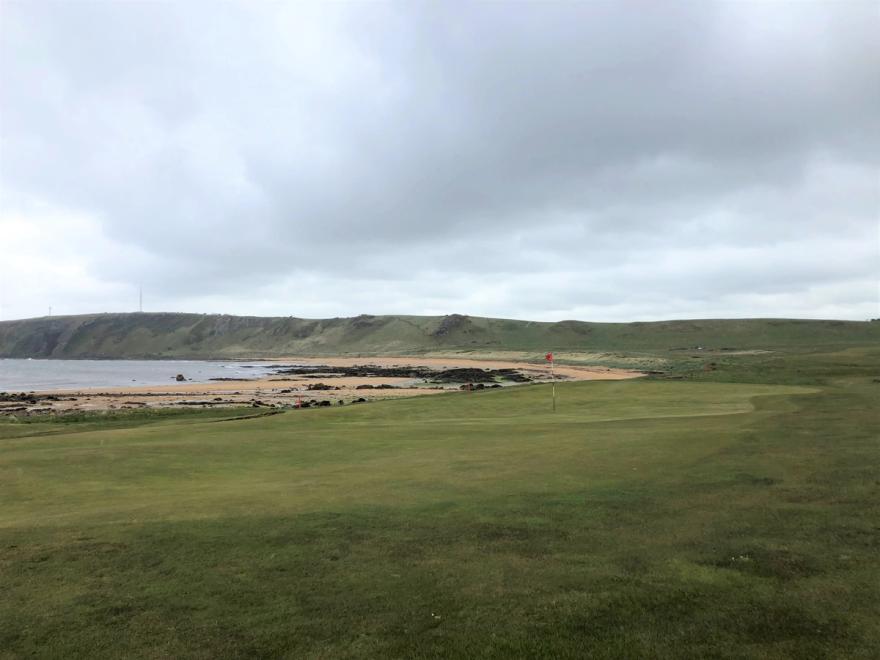
The 11th Green at Elie. Photograph by Jim Hartsell
Unfortunately, the 12th proved to be our last semi-playable hole of the day. We both somehow managed to make bogey on the difficult and beautiful 434 yard cape style par 4. The green is sited perfectly with the rocky beach on the left and tall headlands beyond. It completes one of the great three holes stretches in the world. On the 13th tee, it simply became a survival test. The temperature dropped 20 degrees, seemingly within seconds. At some point, if you make a trip to Scotland, you will likely be confronted at least once with the sudden onset of challenging conditions. The most expensive Goretex waterproofs are useless in this type of weather. Still, I urge you to finish your round no matter how difficult it might be. I am so glad we finished that day at Elie. Almost two years later, it is something we still talk about frequently - with great affection. Experiences like this often become the most precious memories over time.
The remaining holes were all par fours, of course. Visibility was not great and our shots were mainly being played along the ground. We were simply trying to advance the ball forward. In spite of the storm, I still recall the 303 yard 15th hole quite clearly. For some reason, the 40 mph gale shifted directly behind us and we were able to launch our tee shots in the air like a bottle rocket. The drive is played blind (of course) over a tall dune ridge, which then feeds downhill to the green. It is yet another wonderfully blind and fun links golf hole.
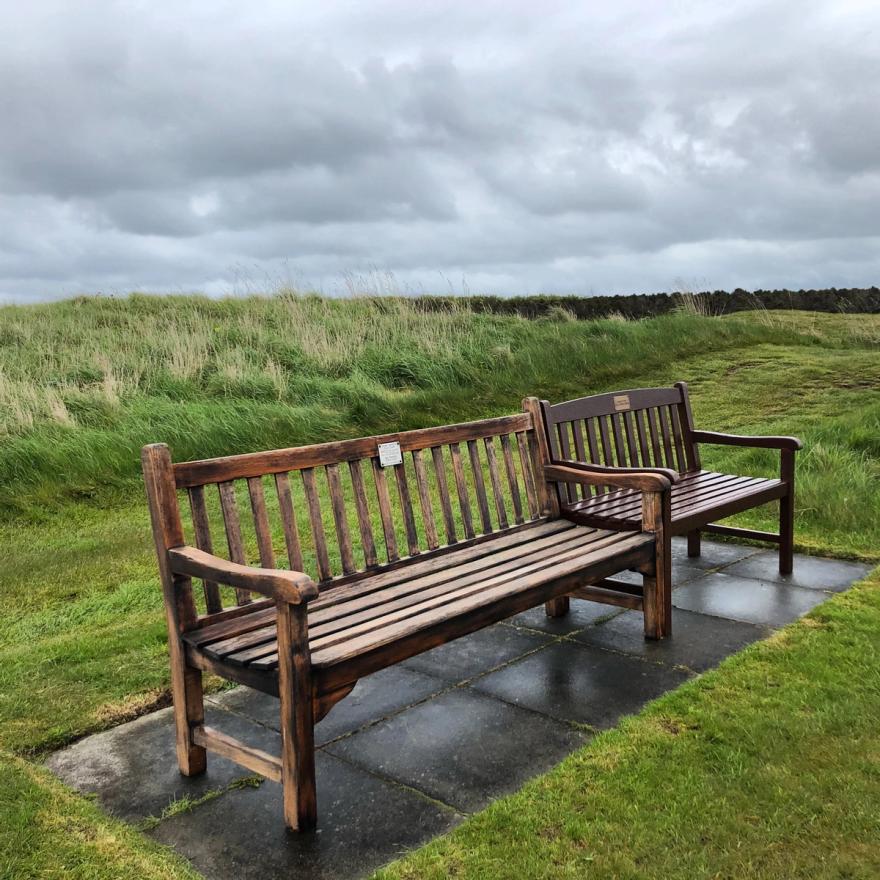
Proper Benches at Elie. Photograph by Jim Hartsell
We managed to get through 16 and 17, which turned us right back into the hurricane force winds that had briefly aided us on 15. I am not exaggerating this statement – at this point, if the ball got more than 3 feet off the ground, it would be blown off the planet. I played the 17th with a choked down 7 iron from the tee, just trying to hit half punch shots about 60 to 80 yards. It was so cold I could not feel my hands or feet. Jake and I were laughing constantly at this point. What else can you do?
It seemed that the conditions eased just slightly on the 18th, which is a lovely and elegant 340 yard par four. There are two perfectly placed bunkers on the left hand side at about 270 yards off the Gents Tee. We dutifully holed out and shook hands, our clothes completely soaked through. Grabbing a change of clothes from the car park, we went into the clubhouse to try to rejoin some semblance of humanity. As we entered the locker room, a gentleman burst out in laughter when he saw us. We must have been a sight indeed. “You guys actually finished? We saw you out there. We walked in after the 9th. I am just now getting warm,” he said with a smile. He introduced himself as Martin from Yorkshire, up from England with a group of golf buddies to play the great links of Fife. We commiserated over the weather and he told me how much they had loved the first 9 holes. “It is a great links,’ he said. I agreed and wished him well for the rest of his golf holiday.
When I was a golf crazy kid growing up in Alabama, I dreamed of one day playing links golf in Scotland. In these dreams, I had an ideal vision of what Scottish links golf must be like - mainly formed from reading about golf history and watching The Open Championship. The Golf House Club, Elie is the perfect physical manifestation of these dreams. It embodies everything that is great about Scottish links golf.
Finally semi-warmed and dry, we returned to the 19th Hole for the all-important recap of the round. Of all of golf’s sacred rituals, this one is perhaps my favorite. It seems to take on an even greater significance after a round in Scotland. When conditions had started to look really bad on the 9th fairway, our faithful photographer Kaylin had wisely sought out the refuge and warmth of the pub. As we sat down at the bar, the bartender looked at us with a laugh and said, “You guys actually played in that?” Grabbing the bottle of Bowmore she said, “You need a drink.” Did I mention that I love Scotland?
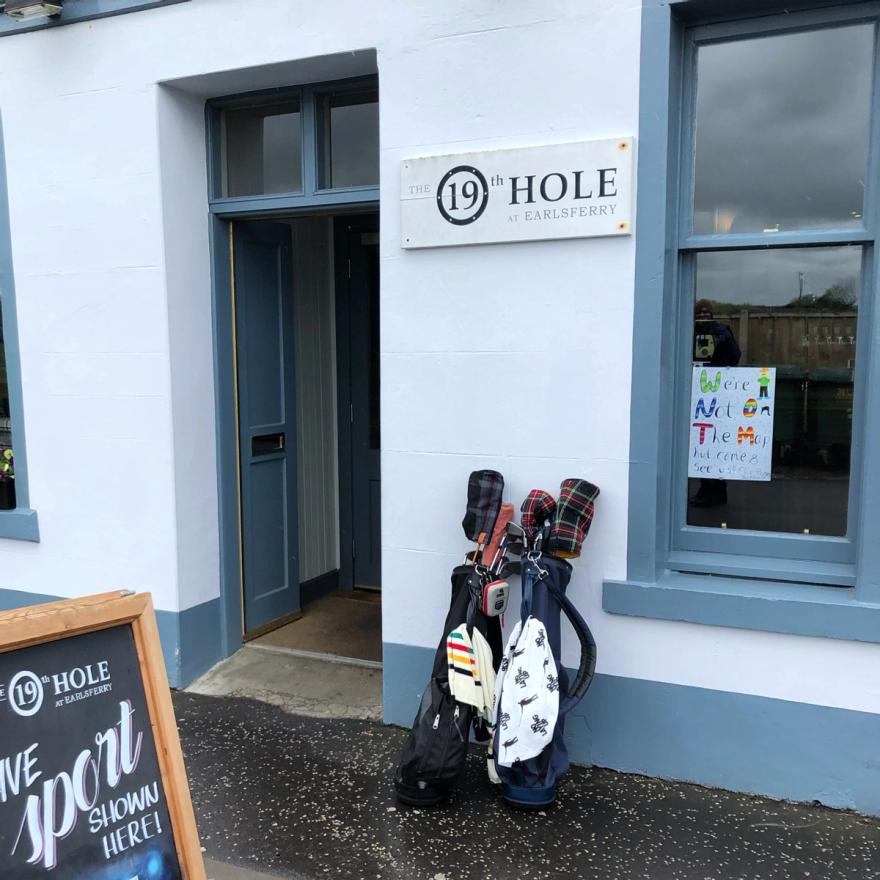
Whiskey and a Pint at The 19th Hole Pub. Photograph by Jim Hartsell
RECOMMENDATIONS
The 19th Hole Pub and the Elie clubhouse are a perfect place for lunch and a pint. The 19th Hole has a good bar menu that includes a great burger and the requisite fish and chips. They really have anything that you would want after a day of golf. Returning to nearby Anstruther, The Dreel Tavern is a place that I have enjoyed over the years. The food is always excellent and it has a great atmosphere. You can spend a lovely evening at The Dreel. Again, you are only a short drive from the wonders of St. Andrews.
Crail, Lundin, Leven and Kinghorn are all golf courses in Fife that are worth a visit. The picturesque village of Crail has a beautiful town square and is a lovely place for an afternoon break from golf. You could easily spend an entire golf holiday in Fife.